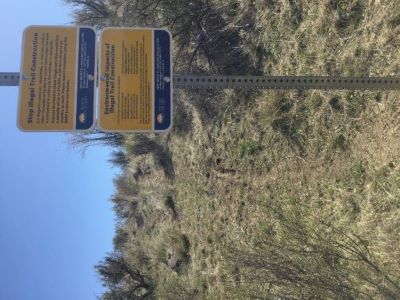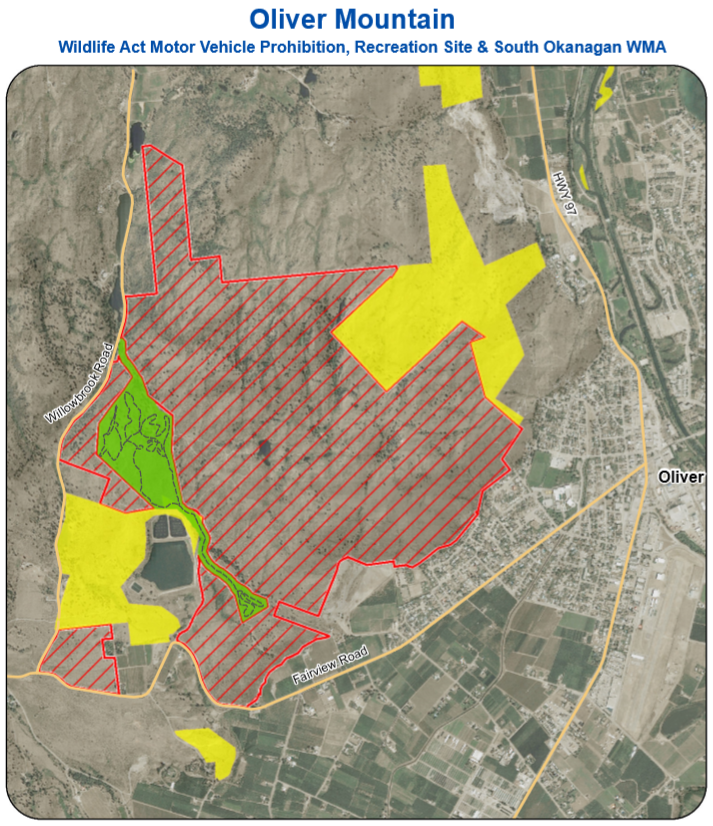Oliver Mountain
Oliver Mountain contains some of the last traces of intact Antelope Brush in B.C. - one of Canada’s most endangered ecosystems - and is an area rich in Indigenous culture and values. Many of the plant and animals that depend on this fragile environment are species at risk in Canada, and are listed as either endangered or threatened in B.C.
Oliver Mountain contains critical habitat for many species that are federally identified under the Species at Risk Act. The multitude of endangered flora and fauna located at Oliver Mountain are highly susceptible to human disturbance and habitat degradation.
On this page:
- Planning Process
- Key species at risk
- South Okanagan Wildlife Management Area
- Illegal trail construction and use of e-bikes
- Invasive Plants
Planning process
In 2013, a planning process began to help lessen the pressure motorized recreation was placing on the sensitive species at Oliver Mountain. This planning process included multiple government ministries and an advisory committee of stakeholder groups that investigated management options for Oliver Mountain during 2014-2015. Their aim was to protect sensitive species while maintaining recreational opportunities. After both public and First Nations consultation, the decision was to follow a two-pronged approach:
- Prohibit motor vehicle use on 348 hectares of Oliver Mountain through a Motor Vehicle Closure Area (under the Wildlife Act)
- Create a 29 hectare Recreation Site (under the Forest and Range Practices Act), which only allows dirt bike use on designated recreational trails
Monitoring
Monitoring is critical to track the effectiveness of this two pronged approach.
A monitoring plan has been established that includes:
- An inventory of threatened species (is the presence of key species, photo points and vegetation plots staying stable?)
- The effectiveness of the closures (what is the number of unauthorized users in restricted areas?)
- The effectiveness of the recreation site (are motorized vehicles staying on designated trails only?)
- Is the ecosystem recovering?
Further management action may be considered if sensitive species continue to be negatively impacted by recreational use of Oliver Mountain.
Key species at risk
Oliver mountain is the home for many species that are at risk of disappearing from the province. The species at risk in this area include:
American Badger
American Badger is Red-listed in British Columbia because the amount of suitable habitat is small and has been adversely affected by human activity. This burrowing mammal depends on key areas of low elevation grasslands and open pine or fir forests which have been largely developed and/or disturbed in recent years. The continued survival of Badger populations in British Columbia requires ongoing habitat protection and stewardship like is underway at Oliver Mountain.
Antelope Brush
The antelope-brush ecosystem of the Okanagan is one of the four most endangered ecosystems in Canada. At a glance, these unique ecosystems appear to be dry, shrubby grasslands, however, they contain many special plants, unusual insects, amphibians, reptiles, birds and mammals. Learn more about Antelope Brush Ecosystems.
Behr’s Hairstreak Butterfly
This species is red-listed and depends on healthy Antelope Brush communities to complete it’s life cycle as the flowering plants provide the nectar that they feed on. The best way to conserve this species is to minimize impacts to intact Antelope Brush communities and when possible, restore degraded ones.
Blotched Tiger Salamander
Tiger Salamanders are Red-listed and only live in a very small portion of the southern interior of BC. These amphibians live in very dry environments, depending on the rare wetlands in these areas for breeding. The unique habitat requirements, along with habitat loss and disturbance are why it’s so important to conserve and protect what little remains.
Gopher Snake
Blue-listed species that can often be mistaken for the Western Rattlesnake, because of similar behaviour and appearance. Gopher snakes are non-venomous and have heads similar in width to it’s body, while rattlesnakes have heads that are much wider than their body. Gopher snakes have been know to imitate rattlesnakes by shaking their tail on dry vegetation to scare off predators.
Great Basin Spadefoot
This blue-listed species (which is closely related to toads) is solitary, spending much of the year burrowed in the soil, awaiting the spring when conditions become warmer and wetter. Spadefoots are often out of sight so it is difficult to know when you might be disrupting them and their habitat. They get their name from the spade-like knob they have on each hind leg which helps them dig and burrow. This species can be distinguished from other frogs or toads by their vertical pupils.
Lewis’s Woodpecker
This blue-listed species hollows out dead trees for nesting, but unlike other woodpeckers it doesn’t generally forage for bugs under bark. Instead, Lewis’ woodpecker tends to perch atop trees and watch for bugs to fly by and catches them in flight. It’s important to maintain large trees to ensure this species has the habitat it needs to nest and fly catch.
Western Rattlesnake
Rattlesnakes are blue-listed and thrive in dry, rocky environments. Although these snakes are often feared, they are actually quite shy and non-aggressive. Rattlesnakes are at risk in BC and play an important role in the ecosystems they inhabit. If you encounter a rattlesnake, remain calm as you distance yourself from it.
Western Yellow-bellied Racer
Western Yellow-bellied Racers are blue-listed. These fast moving snakes are greyish to olive green. Similar to the other snake species found here, this snake is at-risk due to it’s specific habitat needs and the fact that much these areas have been lost due to human activities and development.
South Okanagan Wildlife Management Area
Please be aware that there are two parcels of South Okanagan Wildlife Management Area (SOWMA) land adjacent to the northeast and southwestern portions of Oliver Mountain. It is important to protect these areas as they play a vital role connecting habitat for sensitive species. These areas are important to preserve as they offer a point of reference for intact and healthy functioning ecosystems. Anyone found damaging habitat within a Wildlife Management Area may be subject to enforcement action.
Illegal trail construction and use of e-bikes
Illegal trail construction
Illegal recreation trail construction is a serious and growing issue in the South Okanagan. Because these areas are so dry, impacts from illegal trail building can take ecosystems several decades to recover, even if use of the trails stops. While trail construction may not sound like a serious problem, trail networks tend to start small, and gradually grow over time.
the trails stops. While trail construction may not sound like a serious problem, trail networks tend to start small, and gradually grow over time.
Unauthorized trail construction can result in:
- Spread of invasive plants
- Disruption of wildlife, including species at risk
- Disruption of sensitive plant communities and associated ecosystems
- Soil erosion and soil compaction
- Negative effects on water quality or water flow
- Safety and liability concerns due to improperly built or maintained trials and structures
Grasslands compose less than 1% of the land base in BC (Grasslands Conservation Council of BC). To preserve this area for the future, it is critical that the land be treated with respect and care. It is illegal to develop trails without proper authorization. Report a violation if you see it.
E-bikes also prohibited under Wildlife Act Motor Vehicle Closure
Under the Wildlife Act Motor Vehicle Prohibition Regulation, e-bikes are now included:
- Section 2: A person commits an offence if the person uses or operates a motor vehicle or electric bicycle in an area described in Schedule 1 during the period specified in that schedule for each area.
Invasive plants
Introduced plants, such as Puncturevine, have invaded these very dry habitats. Being a non-native species with no natural enemies, these plants invade natural areas and compete with native plants. Off-road vehicles, shoes and animals can carry the seeds of invasive plants to new locations.
Please check your tires and footwear before entering and leaving this area. Further information can be found at www.oasiss.ca
What can you do?
Use this form to report known or suspected violations of fisheries, wildlife, or environmental protection laws, except salmon-related violations.


